International Human Resources: 7HR007 Contemporary Issues Report
VerifiedAdded on 2023/01/05
|22
|8812
|96
Report
AI Summary
This report examines contemporary issues in international human resources (IHRM), focusing on the differences between international and domestic HRM, various staffing approaches (ethnocentric, polycentric, and geocentric), and the convergence and divergence of HRM systems. It explores recruitment and selection strategies in developing countries and the challenges of remote multicultural working environments in multinational organizations. The report also discusses the EPRG framework and reflects on how the module content will inform future management roles. It provides a comprehensive overview of IHRM practices, including the importance of understanding cultural values, adapting staffing approaches, and managing global operations effectively. The content covers topics like the Unitarian and pluralist perspectives in employee relations, and the impact of these considerations on business strategies.
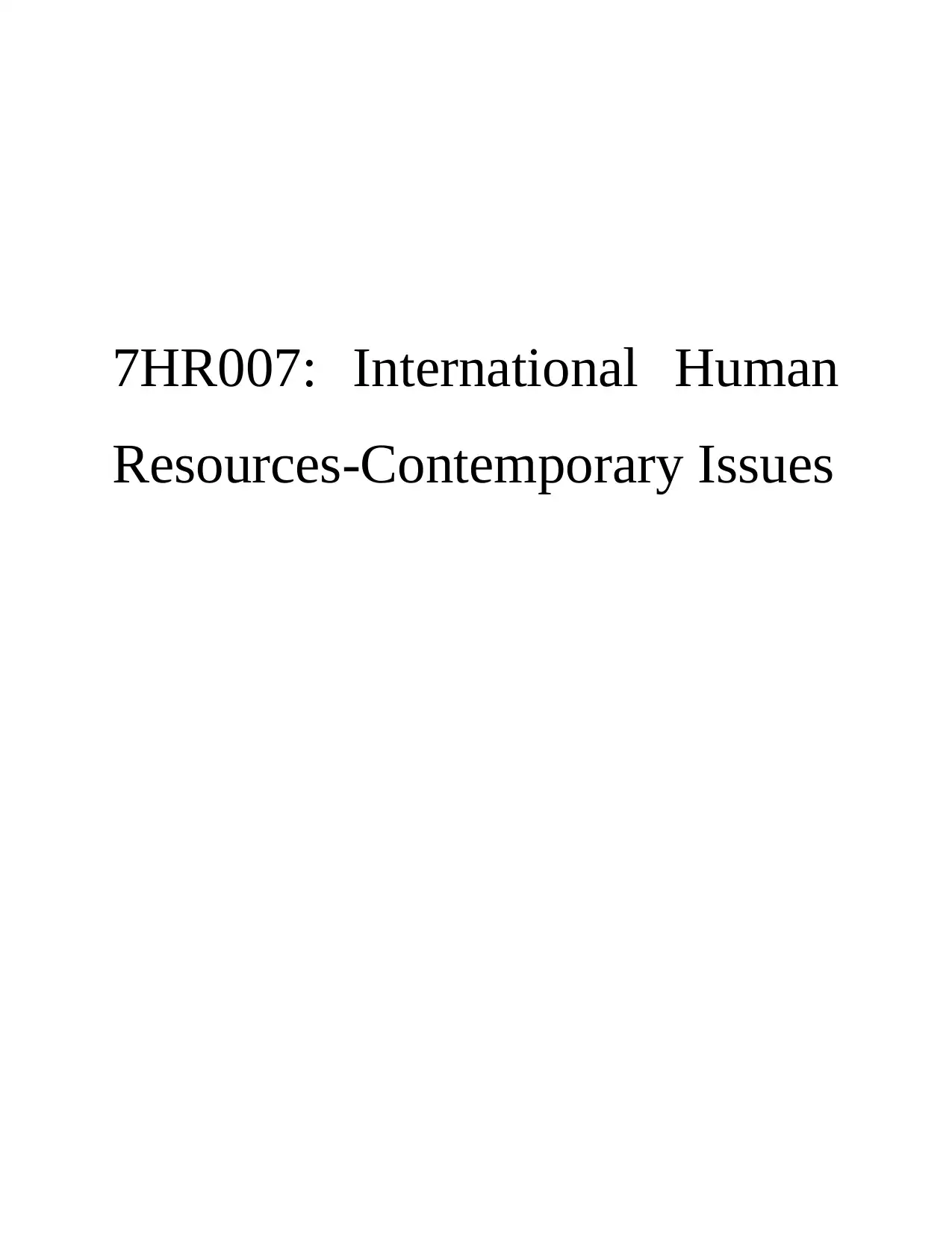
7HR007: International Human
Resources-Contemporary Issues
Resources-Contemporary Issues
Paraphrase This Document
Need a fresh take? Get an instant paraphrase of this document with our AI Paraphraser
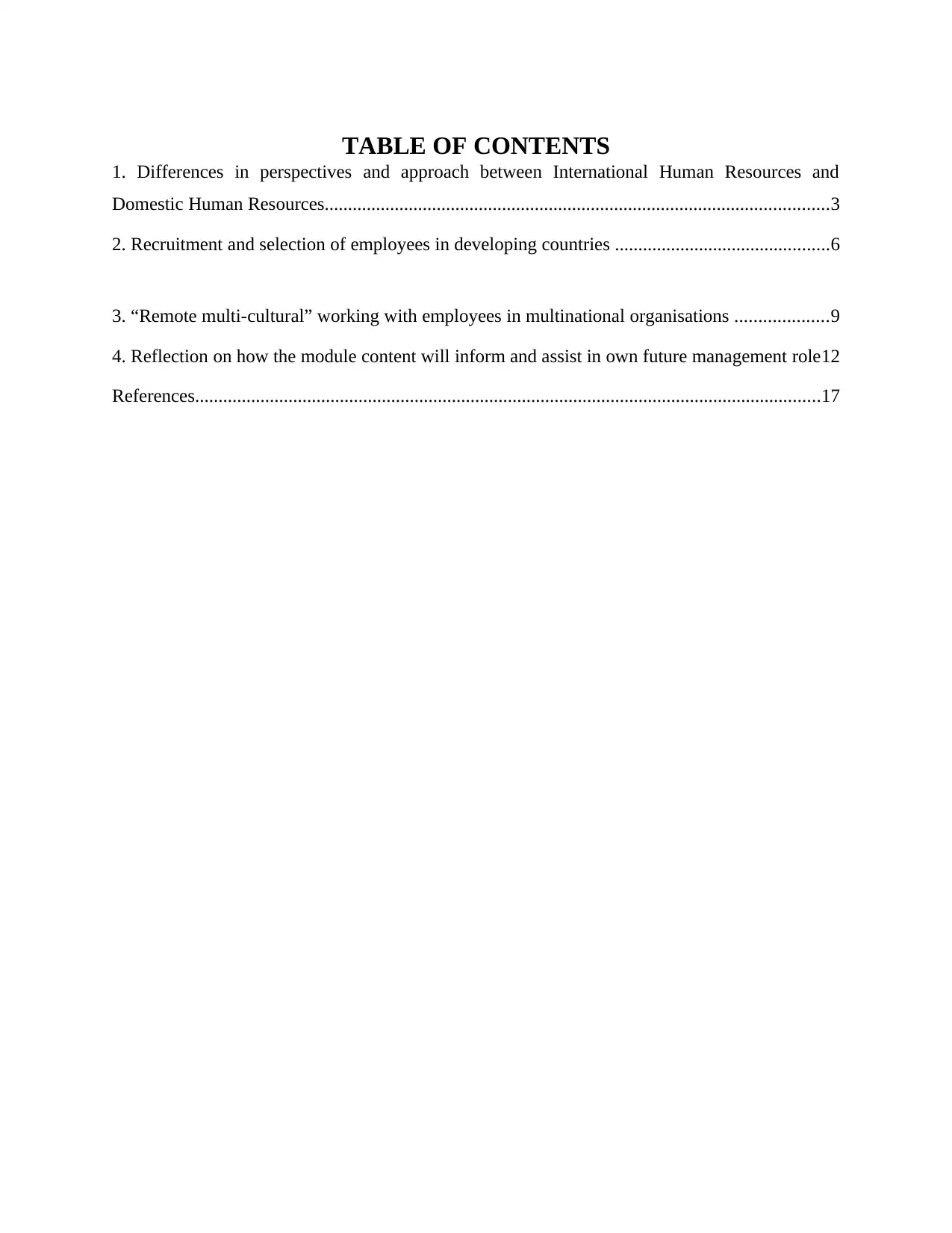
TABLE OF CONTENTS
1. Differences in perspectives and approach between International Human Resources and
Domestic Human Resources............................................................................................................3
2. Recruitment and selection of employees in developing countries ..............................................6
3. “Remote multi-cultural” working with employees in multinational organisations ....................9
4. Reflection on how the module content will inform and assist in own future management role12
References......................................................................................................................................17
1. Differences in perspectives and approach between International Human Resources and
Domestic Human Resources............................................................................................................3
2. Recruitment and selection of employees in developing countries ..............................................6
3. “Remote multi-cultural” working with employees in multinational organisations ....................9
4. Reflection on how the module content will inform and assist in own future management role12
References......................................................................................................................................17
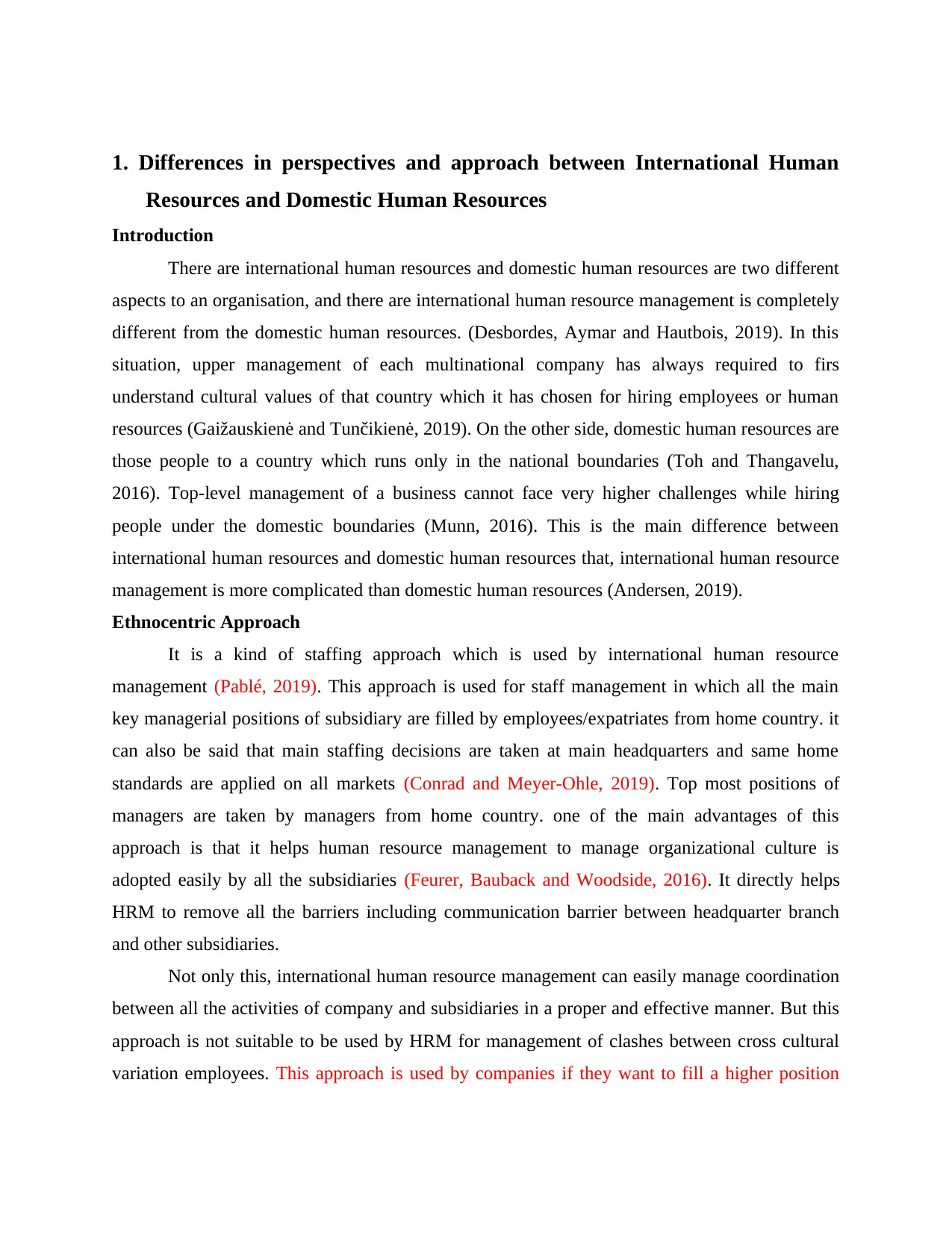
1. Differences in perspectives and approach between International Human
Resources and Domestic Human Resources
Introduction
There are international human resources and domestic human resources are two different
aspects to an organisation, and there are international human resource management is completely
different from the domestic human resources. (Desbordes, Aymar and Hautbois, 2019). In this
situation, upper management of each multinational company has always required to firs
understand cultural values of that country which it has chosen for hiring employees or human
resources (Gaižauskienė and Tunčikienė, 2019). On the other side, domestic human resources are
those people to a country which runs only in the national boundaries (Toh and Thangavelu,
2016). Top-level management of a business cannot face very higher challenges while hiring
people under the domestic boundaries (Munn, 2016). This is the main difference between
international human resources and domestic human resources that, international human resource
management is more complicated than domestic human resources (Andersen, 2019).
Ethnocentric Approach
It is a kind of staffing approach which is used by international human resource
management (Pablé, 2019). This approach is used for staff management in which all the main
key managerial positions of subsidiary are filled by employees/expatriates from home country. it
can also be said that main staffing decisions are taken at main headquarters and same home
standards are applied on all markets (Conrad and Meyer-Ohle, 2019). Top most positions of
managers are taken by managers from home country. one of the main advantages of this
approach is that it helps human resource management to manage organizational culture is
adopted easily by all the subsidiaries (Feurer, Bauback and Woodside, 2016). It directly helps
HRM to remove all the barriers including communication barrier between headquarter branch
and other subsidiaries.
Not only this, international human resource management can easily manage coordination
between all the activities of company and subsidiaries in a proper and effective manner. But this
approach is not suitable to be used by HRM for management of clashes between cross cultural
variation employees. This approach is used by companies if they want to fill a higher position
Resources and Domestic Human Resources
Introduction
There are international human resources and domestic human resources are two different
aspects to an organisation, and there are international human resource management is completely
different from the domestic human resources. (Desbordes, Aymar and Hautbois, 2019). In this
situation, upper management of each multinational company has always required to firs
understand cultural values of that country which it has chosen for hiring employees or human
resources (Gaižauskienė and Tunčikienė, 2019). On the other side, domestic human resources are
those people to a country which runs only in the national boundaries (Toh and Thangavelu,
2016). Top-level management of a business cannot face very higher challenges while hiring
people under the domestic boundaries (Munn, 2016). This is the main difference between
international human resources and domestic human resources that, international human resource
management is more complicated than domestic human resources (Andersen, 2019).
Ethnocentric Approach
It is a kind of staffing approach which is used by international human resource
management (Pablé, 2019). This approach is used for staff management in which all the main
key managerial positions of subsidiary are filled by employees/expatriates from home country. it
can also be said that main staffing decisions are taken at main headquarters and same home
standards are applied on all markets (Conrad and Meyer-Ohle, 2019). Top most positions of
managers are taken by managers from home country. one of the main advantages of this
approach is that it helps human resource management to manage organizational culture is
adopted easily by all the subsidiaries (Feurer, Bauback and Woodside, 2016). It directly helps
HRM to remove all the barriers including communication barrier between headquarter branch
and other subsidiaries.
Not only this, international human resource management can easily manage coordination
between all the activities of company and subsidiaries in a proper and effective manner. But this
approach is not suitable to be used by HRM for management of clashes between cross cultural
variation employees. This approach is used by companies if they want to fill a higher position
⊘ This is a preview!⊘
Do you want full access?
Subscribe today to unlock all pages.

Trusted by 1+ million students worldwide
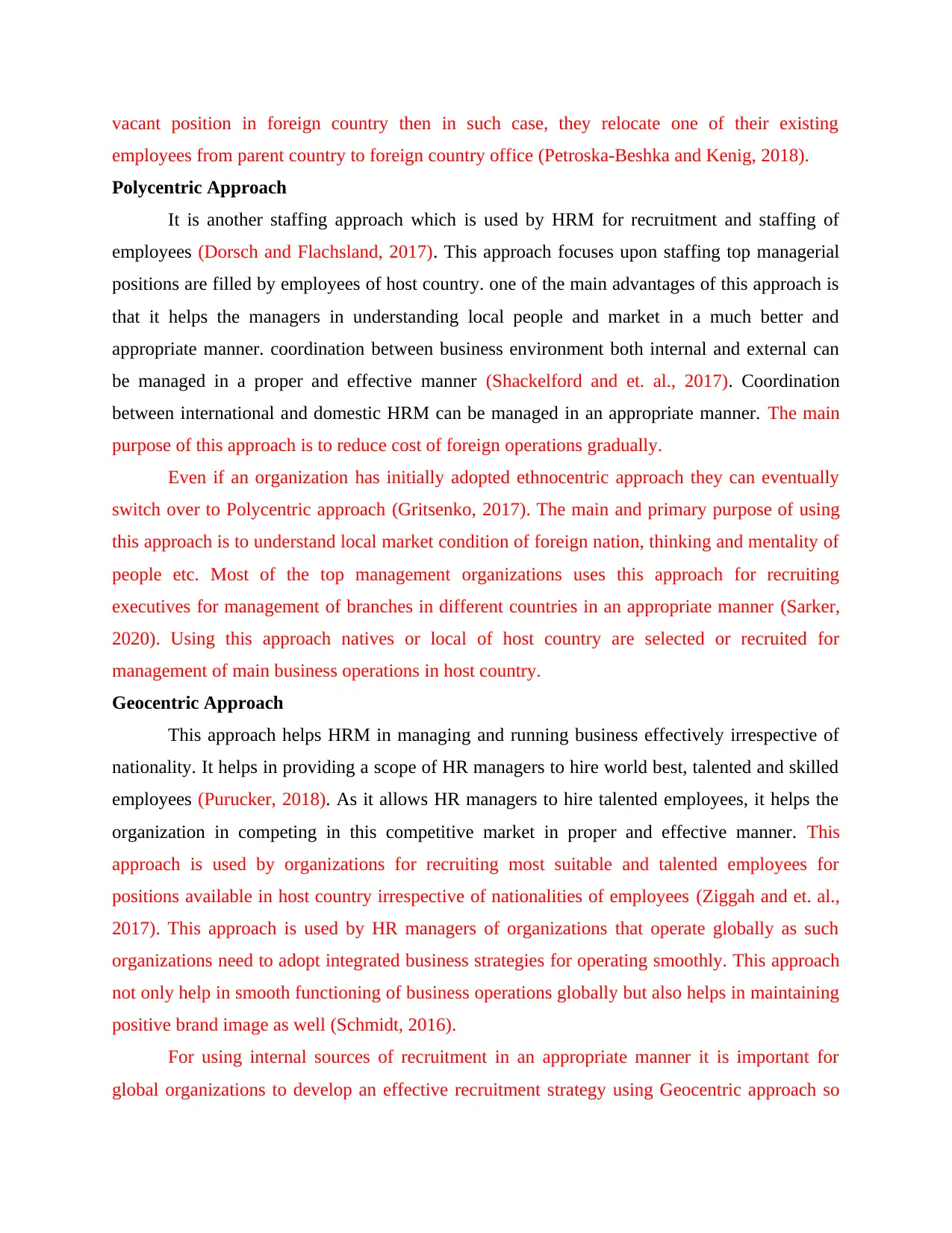
vacant position in foreign country then in such case, they relocate one of their existing
employees from parent country to foreign country office (Petroska-Beshka and Kenig, 2018).
Polycentric Approach
It is another staffing approach which is used by HRM for recruitment and staffing of
employees (Dorsch and Flachsland, 2017). This approach focuses upon staffing top managerial
positions are filled by employees of host country. one of the main advantages of this approach is
that it helps the managers in understanding local people and market in a much better and
appropriate manner. coordination between business environment both internal and external can
be managed in a proper and effective manner (Shackelford and et. al., 2017). Coordination
between international and domestic HRM can be managed in an appropriate manner. The main
purpose of this approach is to reduce cost of foreign operations gradually.
Even if an organization has initially adopted ethnocentric approach they can eventually
switch over to Polycentric approach (Gritsenko, 2017). The main and primary purpose of using
this approach is to understand local market condition of foreign nation, thinking and mentality of
people etc. Most of the top management organizations uses this approach for recruiting
executives for management of branches in different countries in an appropriate manner (Sarker,
2020). Using this approach natives or local of host country are selected or recruited for
management of main business operations in host country.
Geocentric Approach
This approach helps HRM in managing and running business effectively irrespective of
nationality. It helps in providing a scope of HR managers to hire world best, talented and skilled
employees (Purucker, 2018). As it allows HR managers to hire talented employees, it helps the
organization in competing in this competitive market in proper and effective manner. This
approach is used by organizations for recruiting most suitable and talented employees for
positions available in host country irrespective of nationalities of employees (Ziggah and et. al.,
2017). This approach is used by HR managers of organizations that operate globally as such
organizations need to adopt integrated business strategies for operating smoothly. This approach
not only help in smooth functioning of business operations globally but also helps in maintaining
positive brand image as well (Schmidt, 2016).
For using internal sources of recruitment in an appropriate manner it is important for
global organizations to develop an effective recruitment strategy using Geocentric approach so
employees from parent country to foreign country office (Petroska-Beshka and Kenig, 2018).
Polycentric Approach
It is another staffing approach which is used by HRM for recruitment and staffing of
employees (Dorsch and Flachsland, 2017). This approach focuses upon staffing top managerial
positions are filled by employees of host country. one of the main advantages of this approach is
that it helps the managers in understanding local people and market in a much better and
appropriate manner. coordination between business environment both internal and external can
be managed in a proper and effective manner (Shackelford and et. al., 2017). Coordination
between international and domestic HRM can be managed in an appropriate manner. The main
purpose of this approach is to reduce cost of foreign operations gradually.
Even if an organization has initially adopted ethnocentric approach they can eventually
switch over to Polycentric approach (Gritsenko, 2017). The main and primary purpose of using
this approach is to understand local market condition of foreign nation, thinking and mentality of
people etc. Most of the top management organizations uses this approach for recruiting
executives for management of branches in different countries in an appropriate manner (Sarker,
2020). Using this approach natives or local of host country are selected or recruited for
management of main business operations in host country.
Geocentric Approach
This approach helps HRM in managing and running business effectively irrespective of
nationality. It helps in providing a scope of HR managers to hire world best, talented and skilled
employees (Purucker, 2018). As it allows HR managers to hire talented employees, it helps the
organization in competing in this competitive market in proper and effective manner. This
approach is used by organizations for recruiting most suitable and talented employees for
positions available in host country irrespective of nationalities of employees (Ziggah and et. al.,
2017). This approach is used by HR managers of organizations that operate globally as such
organizations need to adopt integrated business strategies for operating smoothly. This approach
not only help in smooth functioning of business operations globally but also helps in maintaining
positive brand image as well (Schmidt, 2016).
For using internal sources of recruitment in an appropriate manner it is important for
global organizations to develop an effective recruitment strategy using Geocentric approach so
Paraphrase This Document
Need a fresh take? Get an instant paraphrase of this document with our AI Paraphraser
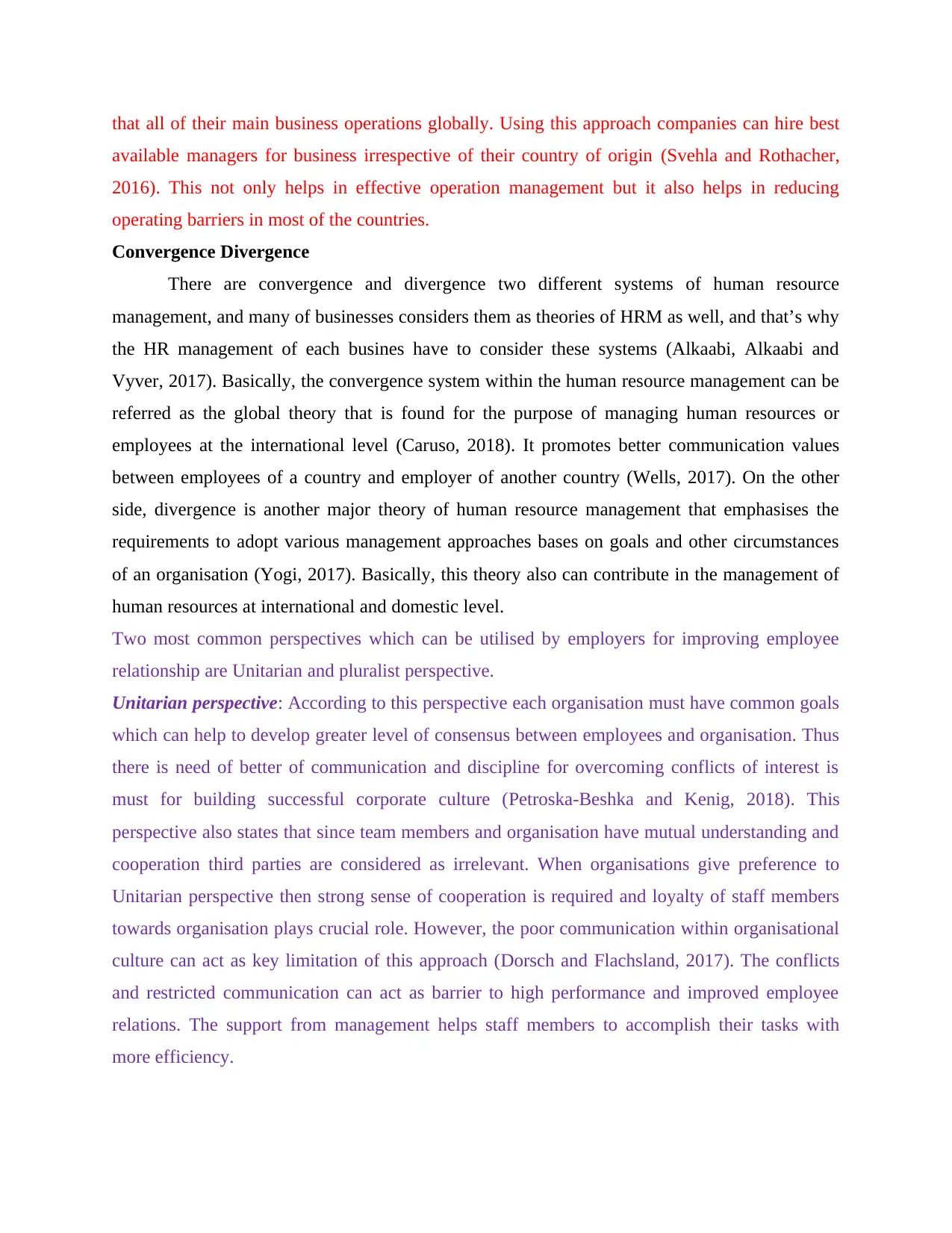
that all of their main business operations globally. Using this approach companies can hire best
available managers for business irrespective of their country of origin (Svehla and Rothacher,
2016). This not only helps in effective operation management but it also helps in reducing
operating barriers in most of the countries.
Convergence Divergence
There are convergence and divergence two different systems of human resource
management, and many of businesses considers them as theories of HRM as well, and that’s why
the HR management of each busines have to consider these systems (Alkaabi, Alkaabi and
Vyver, 2017). Basically, the convergence system within the human resource management can be
referred as the global theory that is found for the purpose of managing human resources or
employees at the international level (Caruso, 2018). It promotes better communication values
between employees of a country and employer of another country (Wells, 2017). On the other
side, divergence is another major theory of human resource management that emphasises the
requirements to adopt various management approaches bases on goals and other circumstances
of an organisation (Yogi, 2017). Basically, this theory also can contribute in the management of
human resources at international and domestic level.
Two most common perspectives which can be utilised by employers for improving employee
relationship are Unitarian and pluralist perspective.
Unitarian perspective: According to this perspective each organisation must have common goals
which can help to develop greater level of consensus between employees and organisation. Thus
there is need of better of communication and discipline for overcoming conflicts of interest is
must for building successful corporate culture (Petroska-Beshka and Kenig, 2018). This
perspective also states that since team members and organisation have mutual understanding and
cooperation third parties are considered as irrelevant. When organisations give preference to
Unitarian perspective then strong sense of cooperation is required and loyalty of staff members
towards organisation plays crucial role. However, the poor communication within organisational
culture can act as key limitation of this approach (Dorsch and Flachsland, 2017). The conflicts
and restricted communication can act as barrier to high performance and improved employee
relations. The support from management helps staff members to accomplish their tasks with
more efficiency.
available managers for business irrespective of their country of origin (Svehla and Rothacher,
2016). This not only helps in effective operation management but it also helps in reducing
operating barriers in most of the countries.
Convergence Divergence
There are convergence and divergence two different systems of human resource
management, and many of businesses considers them as theories of HRM as well, and that’s why
the HR management of each busines have to consider these systems (Alkaabi, Alkaabi and
Vyver, 2017). Basically, the convergence system within the human resource management can be
referred as the global theory that is found for the purpose of managing human resources or
employees at the international level (Caruso, 2018). It promotes better communication values
between employees of a country and employer of another country (Wells, 2017). On the other
side, divergence is another major theory of human resource management that emphasises the
requirements to adopt various management approaches bases on goals and other circumstances
of an organisation (Yogi, 2017). Basically, this theory also can contribute in the management of
human resources at international and domestic level.
Two most common perspectives which can be utilised by employers for improving employee
relationship are Unitarian and pluralist perspective.
Unitarian perspective: According to this perspective each organisation must have common goals
which can help to develop greater level of consensus between employees and organisation. Thus
there is need of better of communication and discipline for overcoming conflicts of interest is
must for building successful corporate culture (Petroska-Beshka and Kenig, 2018). This
perspective also states that since team members and organisation have mutual understanding and
cooperation third parties are considered as irrelevant. When organisations give preference to
Unitarian perspective then strong sense of cooperation is required and loyalty of staff members
towards organisation plays crucial role. However, the poor communication within organisational
culture can act as key limitation of this approach (Dorsch and Flachsland, 2017). The conflicts
and restricted communication can act as barrier to high performance and improved employee
relations. The support from management helps staff members to accomplish their tasks with
more efficiency.
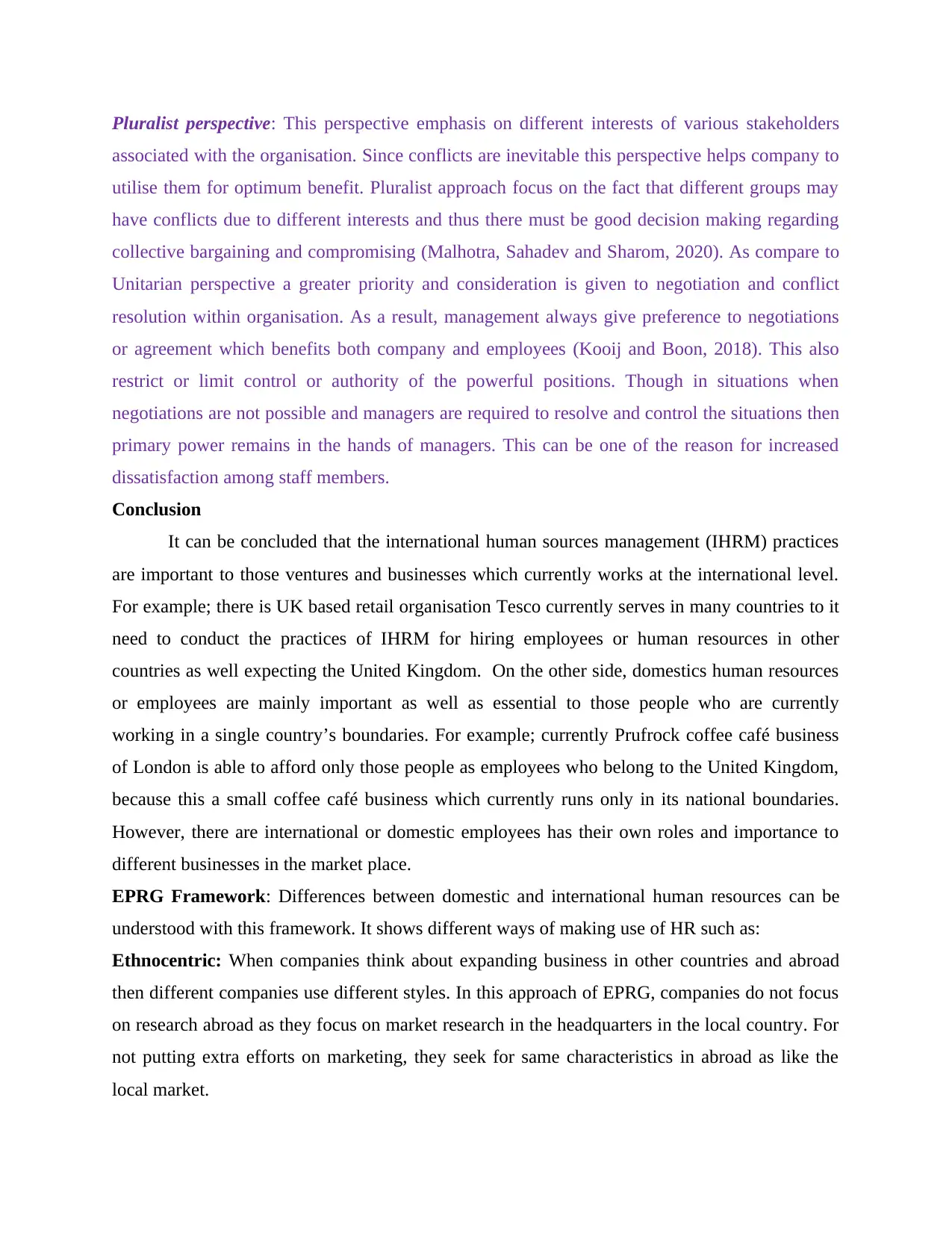
Pluralist perspective: This perspective emphasis on different interests of various stakeholders
associated with the organisation. Since conflicts are inevitable this perspective helps company to
utilise them for optimum benefit. Pluralist approach focus on the fact that different groups may
have conflicts due to different interests and thus there must be good decision making regarding
collective bargaining and compromising (Malhotra, Sahadev and Sharom, 2020). As compare to
Unitarian perspective a greater priority and consideration is given to negotiation and conflict
resolution within organisation. As a result, management always give preference to negotiations
or agreement which benefits both company and employees (Kooij and Boon, 2018). This also
restrict or limit control or authority of the powerful positions. Though in situations when
negotiations are not possible and managers are required to resolve and control the situations then
primary power remains in the hands of managers. This can be one of the reason for increased
dissatisfaction among staff members.
Conclusion
It can be concluded that the international human sources management (IHRM) practices
are important to those ventures and businesses which currently works at the international level.
For example; there is UK based retail organisation Tesco currently serves in many countries to it
need to conduct the practices of IHRM for hiring employees or human resources in other
countries as well expecting the United Kingdom. On the other side, domestics human resources
or employees are mainly important as well as essential to those people who are currently
working in a single country’s boundaries. For example; currently Prufrock coffee café business
of London is able to afford only those people as employees who belong to the United Kingdom,
because this a small coffee café business which currently runs only in its national boundaries.
However, there are international or domestic employees has their own roles and importance to
different businesses in the market place.
EPRG Framework: Differences between domestic and international human resources can be
understood with this framework. It shows different ways of making use of HR such as:
Ethnocentric: When companies think about expanding business in other countries and abroad
then different companies use different styles. In this approach of EPRG, companies do not focus
on research abroad as they focus on market research in the headquarters in the local country. For
not putting extra efforts on marketing, they seek for same characteristics in abroad as like the
local market.
associated with the organisation. Since conflicts are inevitable this perspective helps company to
utilise them for optimum benefit. Pluralist approach focus on the fact that different groups may
have conflicts due to different interests and thus there must be good decision making regarding
collective bargaining and compromising (Malhotra, Sahadev and Sharom, 2020). As compare to
Unitarian perspective a greater priority and consideration is given to negotiation and conflict
resolution within organisation. As a result, management always give preference to negotiations
or agreement which benefits both company and employees (Kooij and Boon, 2018). This also
restrict or limit control or authority of the powerful positions. Though in situations when
negotiations are not possible and managers are required to resolve and control the situations then
primary power remains in the hands of managers. This can be one of the reason for increased
dissatisfaction among staff members.
Conclusion
It can be concluded that the international human sources management (IHRM) practices
are important to those ventures and businesses which currently works at the international level.
For example; there is UK based retail organisation Tesco currently serves in many countries to it
need to conduct the practices of IHRM for hiring employees or human resources in other
countries as well expecting the United Kingdom. On the other side, domestics human resources
or employees are mainly important as well as essential to those people who are currently
working in a single country’s boundaries. For example; currently Prufrock coffee café business
of London is able to afford only those people as employees who belong to the United Kingdom,
because this a small coffee café business which currently runs only in its national boundaries.
However, there are international or domestic employees has their own roles and importance to
different businesses in the market place.
EPRG Framework: Differences between domestic and international human resources can be
understood with this framework. It shows different ways of making use of HR such as:
Ethnocentric: When companies think about expanding business in other countries and abroad
then different companies use different styles. In this approach of EPRG, companies do not focus
on research abroad as they focus on market research in the headquarters in the local country. For
not putting extra efforts on marketing, they seek for same characteristics in abroad as like the
local market.
⊘ This is a preview!⊘
Do you want full access?
Subscribe today to unlock all pages.

Trusted by 1+ million students worldwide
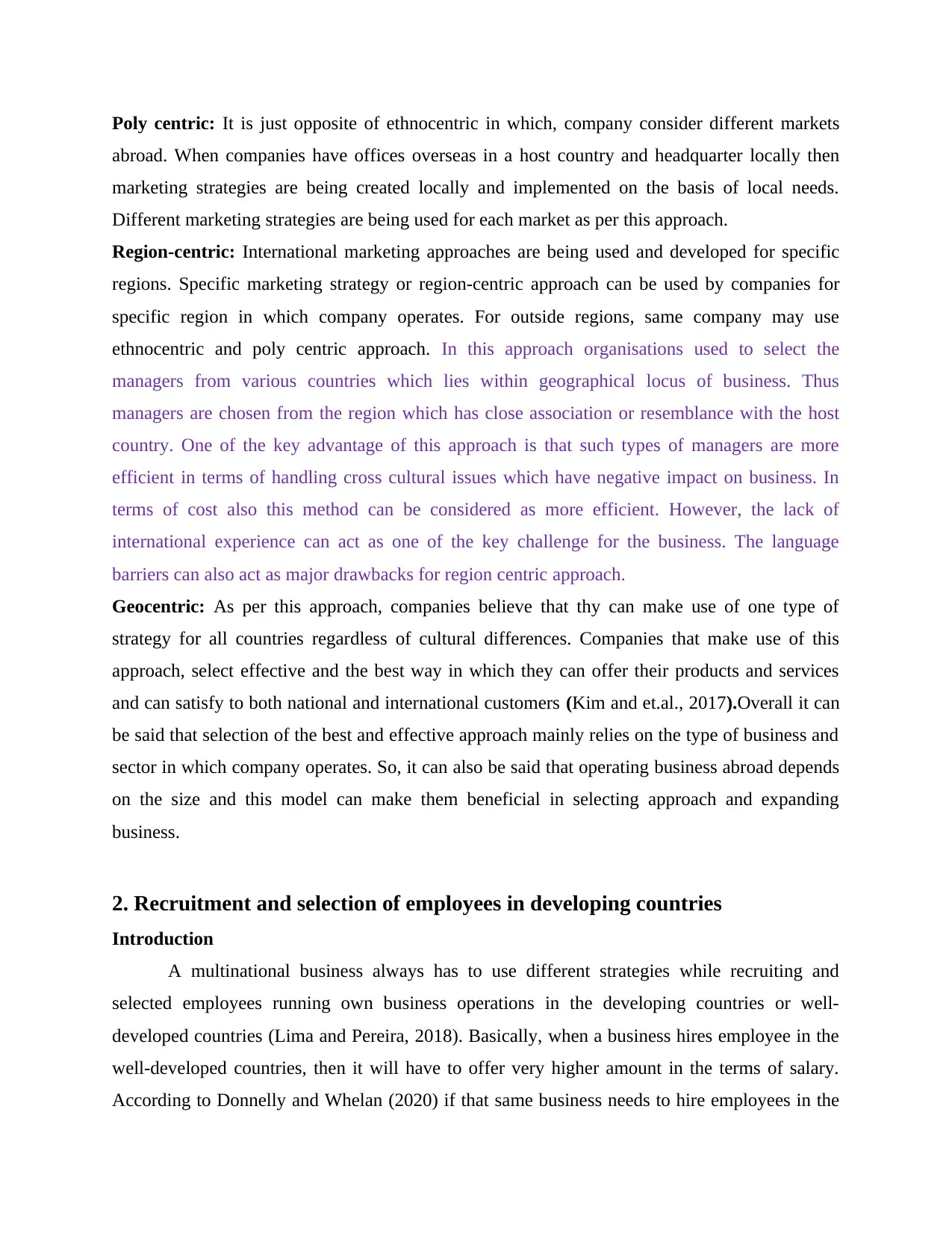
Poly centric: It is just opposite of ethnocentric in which, company consider different markets
abroad. When companies have offices overseas in a host country and headquarter locally then
marketing strategies are being created locally and implemented on the basis of local needs.
Different marketing strategies are being used for each market as per this approach.
Region-centric: International marketing approaches are being used and developed for specific
regions. Specific marketing strategy or region-centric approach can be used by companies for
specific region in which company operates. For outside regions, same company may use
ethnocentric and poly centric approach. In this approach organisations used to select the
managers from various countries which lies within geographical locus of business. Thus
managers are chosen from the region which has close association or resemblance with the host
country. One of the key advantage of this approach is that such types of managers are more
efficient in terms of handling cross cultural issues which have negative impact on business. In
terms of cost also this method can be considered as more efficient. However, the lack of
international experience can act as one of the key challenge for the business. The language
barriers can also act as major drawbacks for region centric approach.
Geocentric: As per this approach, companies believe that thy can make use of one type of
strategy for all countries regardless of cultural differences. Companies that make use of this
approach, select effective and the best way in which they can offer their products and services
and can satisfy to both national and international customers (Kim and et.al., 2017).Overall it can
be said that selection of the best and effective approach mainly relies on the type of business and
sector in which company operates. So, it can also be said that operating business abroad depends
on the size and this model can make them beneficial in selecting approach and expanding
business.
2. Recruitment and selection of employees in developing countries
Introduction
A multinational business always has to use different strategies while recruiting and
selected employees running own business operations in the developing countries or well-
developed countries (Lima and Pereira, 2018). Basically, when a business hires employee in the
well-developed countries, then it will have to offer very higher amount in the terms of salary.
According to Donnelly and Whelan (2020) if that same business needs to hire employees in the
abroad. When companies have offices overseas in a host country and headquarter locally then
marketing strategies are being created locally and implemented on the basis of local needs.
Different marketing strategies are being used for each market as per this approach.
Region-centric: International marketing approaches are being used and developed for specific
regions. Specific marketing strategy or region-centric approach can be used by companies for
specific region in which company operates. For outside regions, same company may use
ethnocentric and poly centric approach. In this approach organisations used to select the
managers from various countries which lies within geographical locus of business. Thus
managers are chosen from the region which has close association or resemblance with the host
country. One of the key advantage of this approach is that such types of managers are more
efficient in terms of handling cross cultural issues which have negative impact on business. In
terms of cost also this method can be considered as more efficient. However, the lack of
international experience can act as one of the key challenge for the business. The language
barriers can also act as major drawbacks for region centric approach.
Geocentric: As per this approach, companies believe that thy can make use of one type of
strategy for all countries regardless of cultural differences. Companies that make use of this
approach, select effective and the best way in which they can offer their products and services
and can satisfy to both national and international customers (Kim and et.al., 2017).Overall it can
be said that selection of the best and effective approach mainly relies on the type of business and
sector in which company operates. So, it can also be said that operating business abroad depends
on the size and this model can make them beneficial in selecting approach and expanding
business.
2. Recruitment and selection of employees in developing countries
Introduction
A multinational business always has to use different strategies while recruiting and
selected employees running own business operations in the developing countries or well-
developed countries (Lima and Pereira, 2018). Basically, when a business hires employee in the
well-developed countries, then it will have to offer very higher amount in the terms of salary.
According to Donnelly and Whelan (2020) if that same business needs to hire employees in the
Paraphrase This Document
Need a fresh take? Get an instant paraphrase of this document with our AI Paraphraser
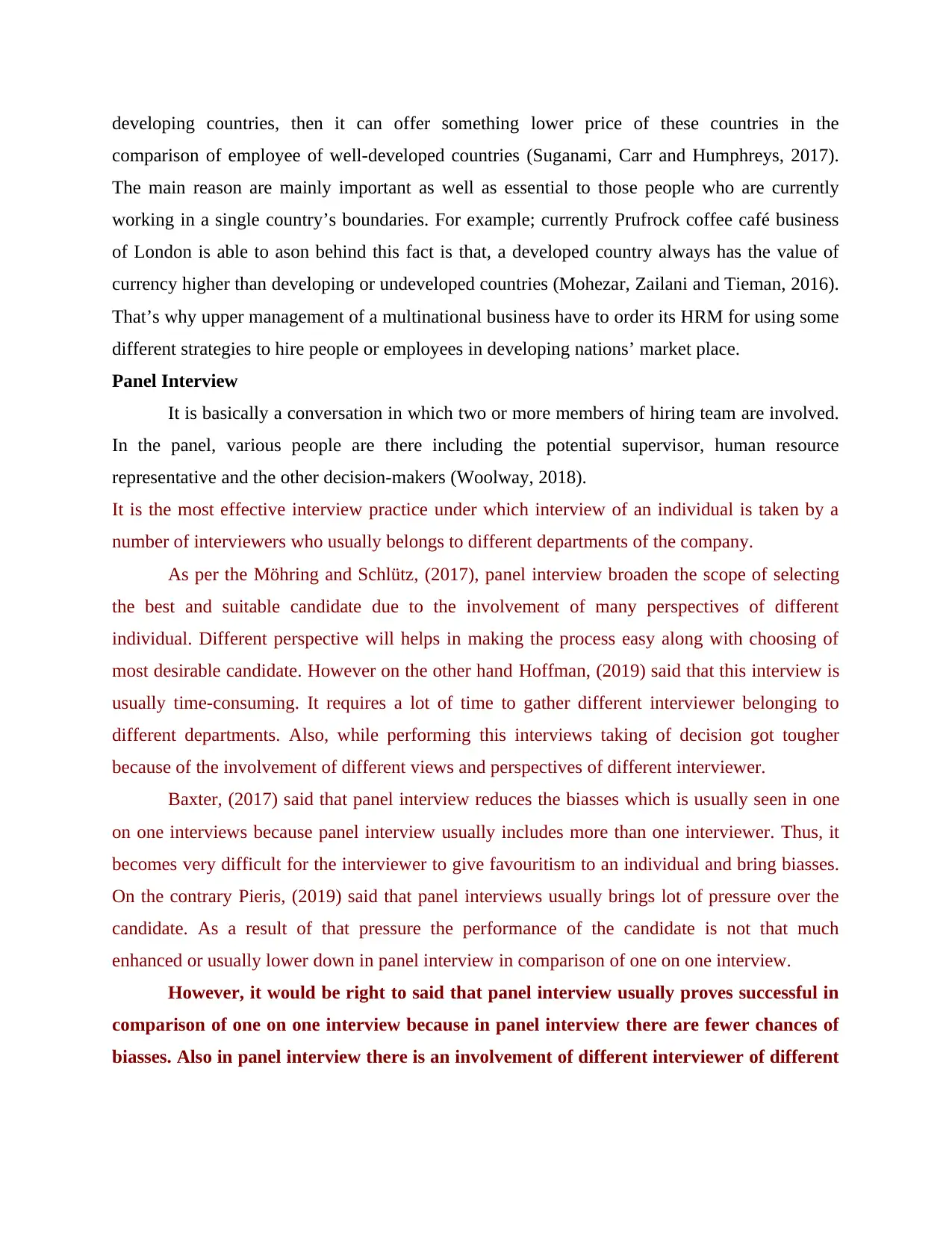
developing countries, then it can offer something lower price of these countries in the
comparison of employee of well-developed countries (Suganami, Carr and Humphreys, 2017).
The main reason are mainly important as well as essential to those people who are currently
working in a single country’s boundaries. For example; currently Prufrock coffee café business
of London is able to ason behind this fact is that, a developed country always has the value of
currency higher than developing or undeveloped countries (Mohezar, Zailani and Tieman, 2016).
That’s why upper management of a multinational business have to order its HRM for using some
different strategies to hire people or employees in developing nations’ market place.
Panel Interview
It is basically a conversation in which two or more members of hiring team are involved.
In the panel, various people are there including the potential supervisor, human resource
representative and the other decision-makers (Woolway, 2018).
It is the most effective interview practice under which interview of an individual is taken by a
number of interviewers who usually belongs to different departments of the company.
As per the Möhring and Schlütz, (2017), panel interview broaden the scope of selecting
the best and suitable candidate due to the involvement of many perspectives of different
individual. Different perspective will helps in making the process easy along with choosing of
most desirable candidate. However on the other hand Hoffman, (2019) said that this interview is
usually time-consuming. It requires a lot of time to gather different interviewer belonging to
different departments. Also, while performing this interviews taking of decision got tougher
because of the involvement of different views and perspectives of different interviewer.
Baxter, (2017) said that panel interview reduces the biasses which is usually seen in one
on one interviews because panel interview usually includes more than one interviewer. Thus, it
becomes very difficult for the interviewer to give favouritism to an individual and bring biasses.
On the contrary Pieris, (2019) said that panel interviews usually brings lot of pressure over the
candidate. As a result of that pressure the performance of the candidate is not that much
enhanced or usually lower down in panel interview in comparison of one on one interview.
However, it would be right to said that panel interview usually proves successful in
comparison of one on one interview because in panel interview there are fewer chances of
biasses. Also in panel interview there is an involvement of different interviewer of different
comparison of employee of well-developed countries (Suganami, Carr and Humphreys, 2017).
The main reason are mainly important as well as essential to those people who are currently
working in a single country’s boundaries. For example; currently Prufrock coffee café business
of London is able to ason behind this fact is that, a developed country always has the value of
currency higher than developing or undeveloped countries (Mohezar, Zailani and Tieman, 2016).
That’s why upper management of a multinational business have to order its HRM for using some
different strategies to hire people or employees in developing nations’ market place.
Panel Interview
It is basically a conversation in which two or more members of hiring team are involved.
In the panel, various people are there including the potential supervisor, human resource
representative and the other decision-makers (Woolway, 2018).
It is the most effective interview practice under which interview of an individual is taken by a
number of interviewers who usually belongs to different departments of the company.
As per the Möhring and Schlütz, (2017), panel interview broaden the scope of selecting
the best and suitable candidate due to the involvement of many perspectives of different
individual. Different perspective will helps in making the process easy along with choosing of
most desirable candidate. However on the other hand Hoffman, (2019) said that this interview is
usually time-consuming. It requires a lot of time to gather different interviewer belonging to
different departments. Also, while performing this interviews taking of decision got tougher
because of the involvement of different views and perspectives of different interviewer.
Baxter, (2017) said that panel interview reduces the biasses which is usually seen in one
on one interviews because panel interview usually includes more than one interviewer. Thus, it
becomes very difficult for the interviewer to give favouritism to an individual and bring biasses.
On the contrary Pieris, (2019) said that panel interviews usually brings lot of pressure over the
candidate. As a result of that pressure the performance of the candidate is not that much
enhanced or usually lower down in panel interview in comparison of one on one interview.
However, it would be right to said that panel interview usually proves successful in
comparison of one on one interview because in panel interview there are fewer chances of
biasses. Also in panel interview there is an involvement of different interviewer of different
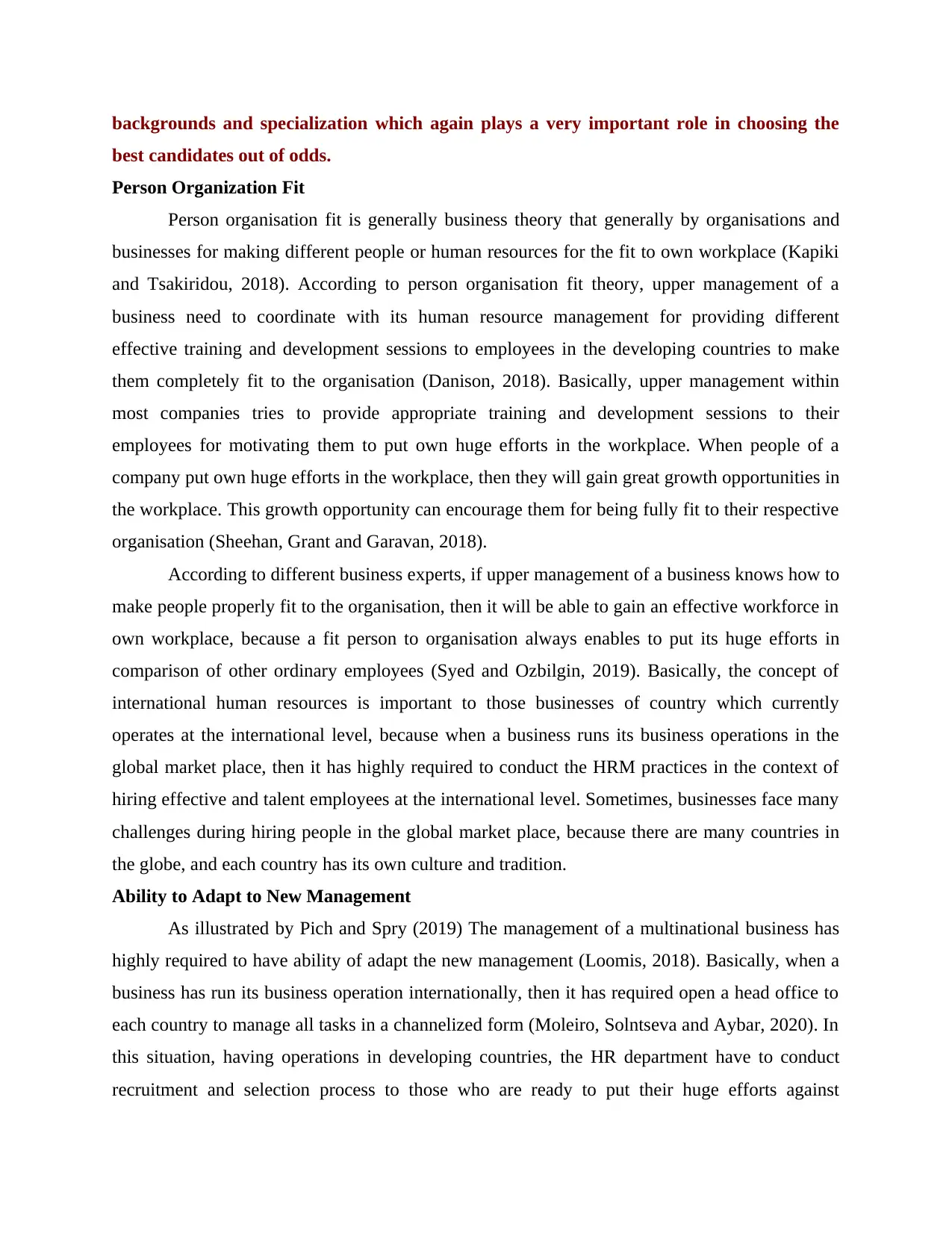
backgrounds and specialization which again plays a very important role in choosing the
best candidates out of odds.
Person Organization Fit
Person organisation fit is generally business theory that generally by organisations and
businesses for making different people or human resources for the fit to own workplace (Kapiki
and Tsakiridou, 2018). According to person organisation fit theory, upper management of a
business need to coordinate with its human resource management for providing different
effective training and development sessions to employees in the developing countries to make
them completely fit to the organisation (Danison, 2018). Basically, upper management within
most companies tries to provide appropriate training and development sessions to their
employees for motivating them to put own huge efforts in the workplace. When people of a
company put own huge efforts in the workplace, then they will gain great growth opportunities in
the workplace. This growth opportunity can encourage them for being fully fit to their respective
organisation (Sheehan, Grant and Garavan, 2018).
According to different business experts, if upper management of a business knows how to
make people properly fit to the organisation, then it will be able to gain an effective workforce in
own workplace, because a fit person to organisation always enables to put its huge efforts in
comparison of other ordinary employees (Syed and Ozbilgin, 2019). Basically, the concept of
international human resources is important to those businesses of country which currently
operates at the international level, because when a business runs its business operations in the
global market place, then it has highly required to conduct the HRM practices in the context of
hiring effective and talent employees at the international level. Sometimes, businesses face many
challenges during hiring people in the global market place, because there are many countries in
the globe, and each country has its own culture and tradition.
Ability to Adapt to New Management
As illustrated by Pich and Spry (2019) The management of a multinational business has
highly required to have ability of adapt the new management (Loomis, 2018). Basically, when a
business has run its business operation internationally, then it has required open a head office to
each country to manage all tasks in a channelized form (Moleiro, Solntseva and Aybar, 2020). In
this situation, having operations in developing countries, the HR department have to conduct
recruitment and selection process to those who are ready to put their huge efforts against
best candidates out of odds.
Person Organization Fit
Person organisation fit is generally business theory that generally by organisations and
businesses for making different people or human resources for the fit to own workplace (Kapiki
and Tsakiridou, 2018). According to person organisation fit theory, upper management of a
business need to coordinate with its human resource management for providing different
effective training and development sessions to employees in the developing countries to make
them completely fit to the organisation (Danison, 2018). Basically, upper management within
most companies tries to provide appropriate training and development sessions to their
employees for motivating them to put own huge efforts in the workplace. When people of a
company put own huge efforts in the workplace, then they will gain great growth opportunities in
the workplace. This growth opportunity can encourage them for being fully fit to their respective
organisation (Sheehan, Grant and Garavan, 2018).
According to different business experts, if upper management of a business knows how to
make people properly fit to the organisation, then it will be able to gain an effective workforce in
own workplace, because a fit person to organisation always enables to put its huge efforts in
comparison of other ordinary employees (Syed and Ozbilgin, 2019). Basically, the concept of
international human resources is important to those businesses of country which currently
operates at the international level, because when a business runs its business operations in the
global market place, then it has highly required to conduct the HRM practices in the context of
hiring effective and talent employees at the international level. Sometimes, businesses face many
challenges during hiring people in the global market place, because there are many countries in
the globe, and each country has its own culture and tradition.
Ability to Adapt to New Management
As illustrated by Pich and Spry (2019) The management of a multinational business has
highly required to have ability of adapt the new management (Loomis, 2018). Basically, when a
business has run its business operation internationally, then it has required open a head office to
each country to manage all tasks in a channelized form (Moleiro, Solntseva and Aybar, 2020). In
this situation, having operations in developing countries, the HR department have to conduct
recruitment and selection process to those who are ready to put their huge efforts against
⊘ This is a preview!⊘
Do you want full access?
Subscribe today to unlock all pages.

Trusted by 1+ million students worldwide
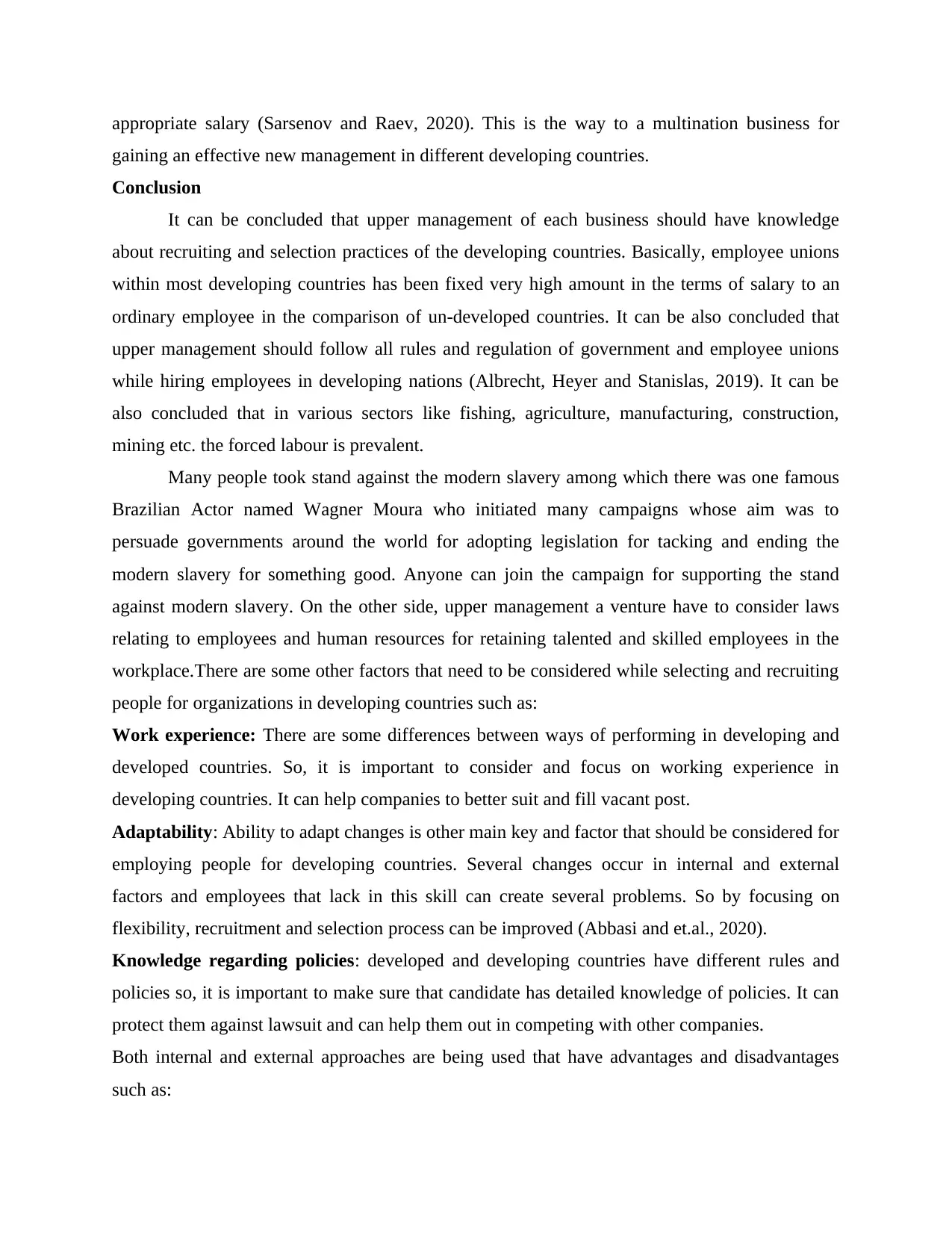
appropriate salary (Sarsenov and Raev, 2020). This is the way to a multination business for
gaining an effective new management in different developing countries.
Conclusion
It can be concluded that upper management of each business should have knowledge
about recruiting and selection practices of the developing countries. Basically, employee unions
within most developing countries has been fixed very high amount in the terms of salary to an
ordinary employee in the comparison of un-developed countries. It can be also concluded that
upper management should follow all rules and regulation of government and employee unions
while hiring employees in developing nations (Albrecht, Heyer and Stanislas, 2019). It can be
also concluded that in various sectors like fishing, agriculture, manufacturing, construction,
mining etc. the forced labour is prevalent.
Many people took stand against the modern slavery among which there was one famous
Brazilian Actor named Wagner Moura who initiated many campaigns whose aim was to
persuade governments around the world for adopting legislation for tacking and ending the
modern slavery for something good. Anyone can join the campaign for supporting the stand
against modern slavery. On the other side, upper management a venture have to consider laws
relating to employees and human resources for retaining talented and skilled employees in the
workplace.There are some other factors that need to be considered while selecting and recruiting
people for organizations in developing countries such as:
Work experience: There are some differences between ways of performing in developing and
developed countries. So, it is important to consider and focus on working experience in
developing countries. It can help companies to better suit and fill vacant post.
Adaptability: Ability to adapt changes is other main key and factor that should be considered for
employing people for developing countries. Several changes occur in internal and external
factors and employees that lack in this skill can create several problems. So by focusing on
flexibility, recruitment and selection process can be improved (Abbasi and et.al., 2020).
Knowledge regarding policies: developed and developing countries have different rules and
policies so, it is important to make sure that candidate has detailed knowledge of policies. It can
protect them against lawsuit and can help them out in competing with other companies.
Both internal and external approaches are being used that have advantages and disadvantages
such as:
gaining an effective new management in different developing countries.
Conclusion
It can be concluded that upper management of each business should have knowledge
about recruiting and selection practices of the developing countries. Basically, employee unions
within most developing countries has been fixed very high amount in the terms of salary to an
ordinary employee in the comparison of un-developed countries. It can be also concluded that
upper management should follow all rules and regulation of government and employee unions
while hiring employees in developing nations (Albrecht, Heyer and Stanislas, 2019). It can be
also concluded that in various sectors like fishing, agriculture, manufacturing, construction,
mining etc. the forced labour is prevalent.
Many people took stand against the modern slavery among which there was one famous
Brazilian Actor named Wagner Moura who initiated many campaigns whose aim was to
persuade governments around the world for adopting legislation for tacking and ending the
modern slavery for something good. Anyone can join the campaign for supporting the stand
against modern slavery. On the other side, upper management a venture have to consider laws
relating to employees and human resources for retaining talented and skilled employees in the
workplace.There are some other factors that need to be considered while selecting and recruiting
people for organizations in developing countries such as:
Work experience: There are some differences between ways of performing in developing and
developed countries. So, it is important to consider and focus on working experience in
developing countries. It can help companies to better suit and fill vacant post.
Adaptability: Ability to adapt changes is other main key and factor that should be considered for
employing people for developing countries. Several changes occur in internal and external
factors and employees that lack in this skill can create several problems. So by focusing on
flexibility, recruitment and selection process can be improved (Abbasi and et.al., 2020).
Knowledge regarding policies: developed and developing countries have different rules and
policies so, it is important to make sure that candidate has detailed knowledge of policies. It can
protect them against lawsuit and can help them out in competing with other companies.
Both internal and external approaches are being used that have advantages and disadvantages
such as:
Paraphrase This Document
Need a fresh take? Get an instant paraphrase of this document with our AI Paraphraser
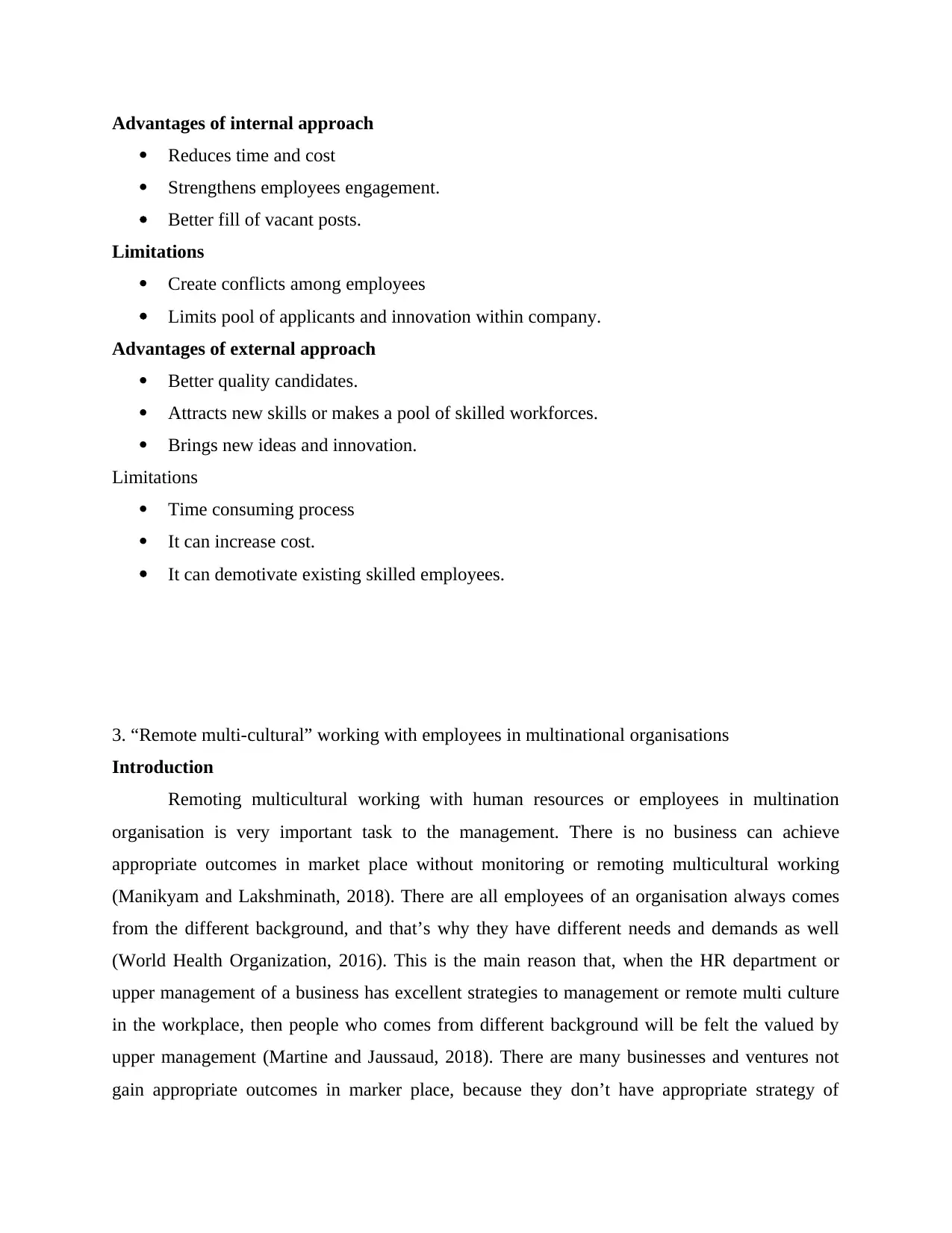
Advantages of internal approach
Reduces time and cost
Strengthens employees engagement.
Better fill of vacant posts.
Limitations
Create conflicts among employees
Limits pool of applicants and innovation within company.
Advantages of external approach
Better quality candidates.
Attracts new skills or makes a pool of skilled workforces.
Brings new ideas and innovation.
Limitations
Time consuming process
It can increase cost.
It can demotivate existing skilled employees.
3. “Remote multi-cultural” working with employees in multinational organisations
Introduction
Remoting multicultural working with human resources or employees in multination
organisation is very important task to the management. There is no business can achieve
appropriate outcomes in market place without monitoring or remoting multicultural working
(Manikyam and Lakshminath, 2018). There are all employees of an organisation always comes
from the different background, and that’s why they have different needs and demands as well
(World Health Organization, 2016). This is the main reason that, when the HR department or
upper management of a business has excellent strategies to management or remote multi culture
in the workplace, then people who comes from different background will be felt the valued by
upper management (Martine and Jaussaud, 2018). There are many businesses and ventures not
gain appropriate outcomes in marker place, because they don’t have appropriate strategy of
Reduces time and cost
Strengthens employees engagement.
Better fill of vacant posts.
Limitations
Create conflicts among employees
Limits pool of applicants and innovation within company.
Advantages of external approach
Better quality candidates.
Attracts new skills or makes a pool of skilled workforces.
Brings new ideas and innovation.
Limitations
Time consuming process
It can increase cost.
It can demotivate existing skilled employees.
3. “Remote multi-cultural” working with employees in multinational organisations
Introduction
Remoting multicultural working with human resources or employees in multination
organisation is very important task to the management. There is no business can achieve
appropriate outcomes in market place without monitoring or remoting multicultural working
(Manikyam and Lakshminath, 2018). There are all employees of an organisation always comes
from the different background, and that’s why they have different needs and demands as well
(World Health Organization, 2016). This is the main reason that, when the HR department or
upper management of a business has excellent strategies to management or remote multi culture
in the workplace, then people who comes from different background will be felt the valued by
upper management (Martine and Jaussaud, 2018). There are many businesses and ventures not
gain appropriate outcomes in marker place, because they don’t have appropriate strategy of
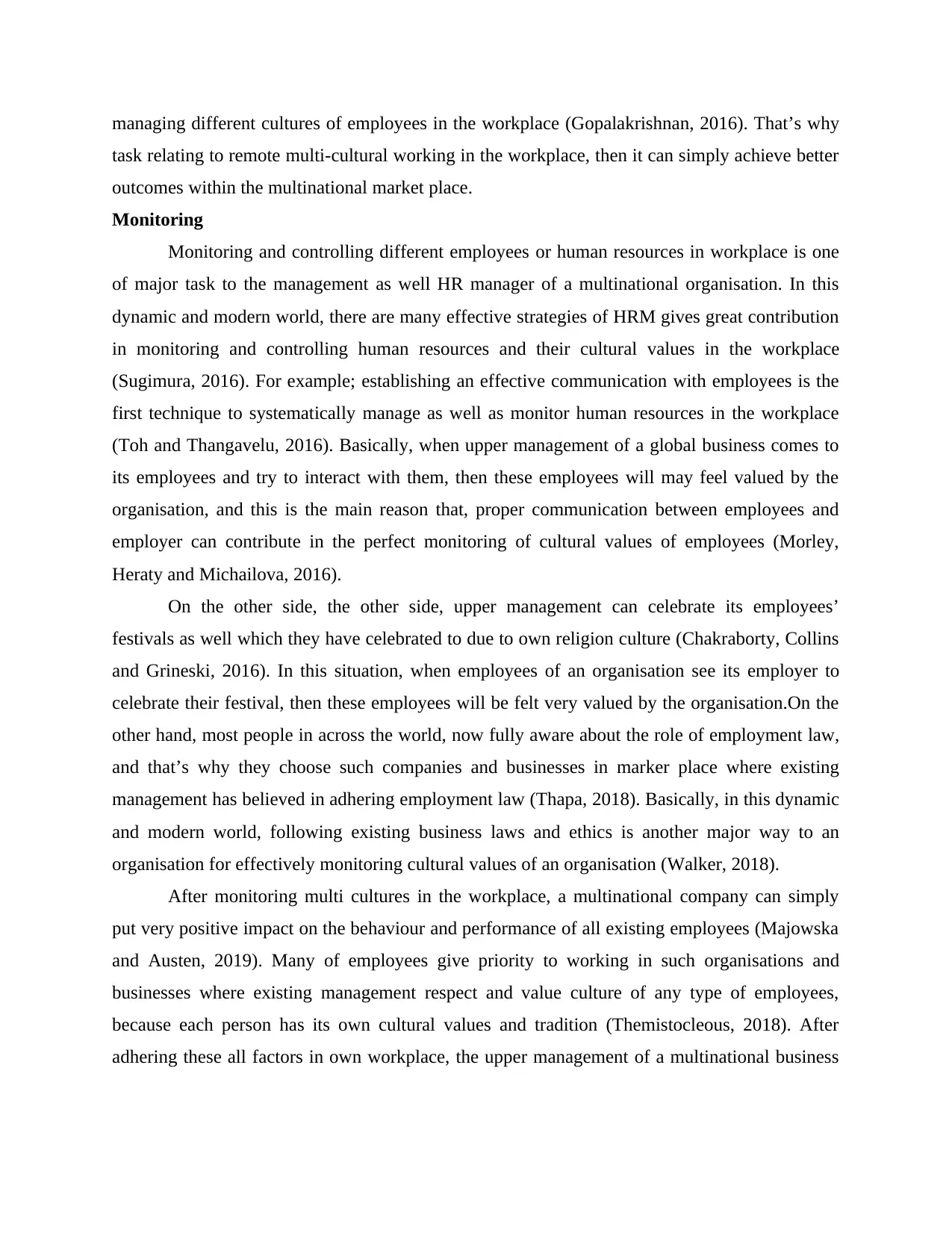
managing different cultures of employees in the workplace (Gopalakrishnan, 2016). That’s why
task relating to remote multi-cultural working in the workplace, then it can simply achieve better
outcomes within the multinational market place.
Monitoring
Monitoring and controlling different employees or human resources in workplace is one
of major task to the management as well HR manager of a multinational organisation. In this
dynamic and modern world, there are many effective strategies of HRM gives great contribution
in monitoring and controlling human resources and their cultural values in the workplace
(Sugimura, 2016). For example; establishing an effective communication with employees is the
first technique to systematically manage as well as monitor human resources in the workplace
(Toh and Thangavelu, 2016). Basically, when upper management of a global business comes to
its employees and try to interact with them, then these employees will may feel valued by the
organisation, and this is the main reason that, proper communication between employees and
employer can contribute in the perfect monitoring of cultural values of employees (Morley,
Heraty and Michailova, 2016).
On the other side, the other side, upper management can celebrate its employees’
festivals as well which they have celebrated to due to own religion culture (Chakraborty, Collins
and Grineski, 2016). In this situation, when employees of an organisation see its employer to
celebrate their festival, then these employees will be felt very valued by the organisation.On the
other hand, most people in across the world, now fully aware about the role of employment law,
and that’s why they choose such companies and businesses in marker place where existing
management has believed in adhering employment law (Thapa, 2018). Basically, in this dynamic
and modern world, following existing business laws and ethics is another major way to an
organisation for effectively monitoring cultural values of an organisation (Walker, 2018).
After monitoring multi cultures in the workplace, a multinational company can simply
put very positive impact on the behaviour and performance of all existing employees (Majowska
and Austen, 2019). Many of employees give priority to working in such organisations and
businesses where existing management respect and value culture of any type of employees,
because each person has its own cultural values and tradition (Themistocleous, 2018). After
adhering these all factors in own workplace, the upper management of a multinational business
task relating to remote multi-cultural working in the workplace, then it can simply achieve better
outcomes within the multinational market place.
Monitoring
Monitoring and controlling different employees or human resources in workplace is one
of major task to the management as well HR manager of a multinational organisation. In this
dynamic and modern world, there are many effective strategies of HRM gives great contribution
in monitoring and controlling human resources and their cultural values in the workplace
(Sugimura, 2016). For example; establishing an effective communication with employees is the
first technique to systematically manage as well as monitor human resources in the workplace
(Toh and Thangavelu, 2016). Basically, when upper management of a global business comes to
its employees and try to interact with them, then these employees will may feel valued by the
organisation, and this is the main reason that, proper communication between employees and
employer can contribute in the perfect monitoring of cultural values of employees (Morley,
Heraty and Michailova, 2016).
On the other side, the other side, upper management can celebrate its employees’
festivals as well which they have celebrated to due to own religion culture (Chakraborty, Collins
and Grineski, 2016). In this situation, when employees of an organisation see its employer to
celebrate their festival, then these employees will be felt very valued by the organisation.On the
other hand, most people in across the world, now fully aware about the role of employment law,
and that’s why they choose such companies and businesses in marker place where existing
management has believed in adhering employment law (Thapa, 2018). Basically, in this dynamic
and modern world, following existing business laws and ethics is another major way to an
organisation for effectively monitoring cultural values of an organisation (Walker, 2018).
After monitoring multi cultures in the workplace, a multinational company can simply
put very positive impact on the behaviour and performance of all existing employees (Majowska
and Austen, 2019). Many of employees give priority to working in such organisations and
businesses where existing management respect and value culture of any type of employees,
because each person has its own cultural values and tradition (Themistocleous, 2018). After
adhering these all factors in own workplace, the upper management of a multinational business
⊘ This is a preview!⊘
Do you want full access?
Subscribe today to unlock all pages.

Trusted by 1+ million students worldwide
1 out of 22
Related Documents
Your All-in-One AI-Powered Toolkit for Academic Success.
+13062052269
info@desklib.com
Available 24*7 on WhatsApp / Email
![[object Object]](/_next/static/media/star-bottom.7253800d.svg)
Unlock your academic potential
Copyright © 2020–2025 A2Z Services. All Rights Reserved. Developed and managed by ZUCOL.



